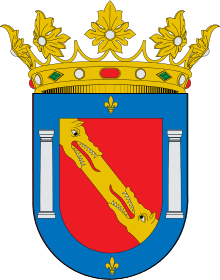Duke of Gor

The title Dukedom of Gor or Duque de Gor was created by King Charles IV of Spain on 4 October 1802, to be given to Nicolás Mauricio Alvarez de las Asturias Bohorques and his descendants.[1]
Gor and Gorafe, heads of the Dukedom farming lands, are located within the province of Granada, and their castles have been labelled by the Junta de Andalucia ("Autonomous Andalusian Government" in Seville) as B.I.C. ("Bien de Interes Cultural") since June 1985.
Library
The first duke, Nicolás Mauricio Álvarez de las Asturias Bohorques, lived in Granada in a palace renovated later by Francisco Gimenez, and had acquired a library containing 6,000 manuscripts, books and Arabic documents dating from the 14th and 15th century, from the time of the Emirate of Granada. Arevalo was acquainted with American writer Washington Irving, later Minister to Spain (1842 to 1845); Irving stayed with the duke of Gor during his first visit to Spain, in 1829, and used the duke's library for his Chronicles of the Conquest of Granada (1829).[2]
The collection was acquired in 1962 by the multimillionaire banker Bartolomé March, one of General Francisco Franco's financial advisers. The Dukes of Gor's collection, which formed the largest and most important part of March's collection, was catalogized in 1907.[3]
One notable book in the duke's library was a first edition of Gaspar Correia's Lendas da Índia.[4]
List of Dukes de Gor
| Name | Period | |
|---|---|---|
| I | Nicolás Mauricio Álvarez de las Asturias Bohorques | 1803-1825 |
| II | Mauricio Nicolás Álvarez de las Asturias Bohorques y Chacón | 1825-1851 |
| III | Mauricio Álvarez de las Asturias Bohorques y Guiráldez | 1851-1877 |
| IV | Mauricio Álvarez de las Asturias Bohorques y Ponce de León | 1877-1930 |
| V | Mauricio Álvarez de las Asturias Bohorques y Goyeneche | 1930-1963 |
| VI | Mauricio Álvarez de las Asturias Bohorques y Silva | 1963 |
During the dukedome of Duke II tithes were abolished in Spain, and nobles who formerly received those tithes were compensated by the Crown. For the duke of Gor, the 1859 compensation amounted to 2.1 million reales, a significant part of the duke's total liquid capital of 2.9 million reales.[5]
Duke III served on a diplomatic mission to Saint Petersburg (December 1856 - June 1857) and was accompanied by a young Juan Valera y Alcalá-Galiano, who "poke[d] gentle fun at the duke" in his Cartas desde Rusia.[6]
References
- ↑ Vázquez, Oscar E. (2001). Inventing the Art Collection: Patrons, Markets, and the State in Nineteenth-century Spain. Penn State UP. p. 234. ISBN 9780271020846.
- ↑ Jones, Brian Jay (2011). Washington Irving: An American Original. Skyhorse. p. 207. ISBN 9781611453546.
- ↑ Kristeller, Paul Oskar (1989). Iter Italicum. Iter Italicum: A Finding List of Uncatalogued Or Incompletely Catalogued Humanistic Manuscripts of the Renaissance in Italian and Other Libraries. 4. Brill. p. 591. ISBN 9789004077195.
- ↑ Corrêa, Gaspar (1869). Henry E. J. Stanley, ed. The Three Voyages of Vasco de Gama, and His Viceroyalty: From the Lendas Da India of Gaspar Corrêa. Works issued by the Hakluyt Society. 42. Hakluyt Society. p. iv.
- ↑ Shubert, Adrian (2003). A Social History of Modern Spain. Routledge. p. 60. ISBN 9780203421215.
- ↑ Tracy Chevalier, ed. (1997). Encyclopedia of the Essay. Taylor & Francis. p. 1681. ISBN 9780203303689.